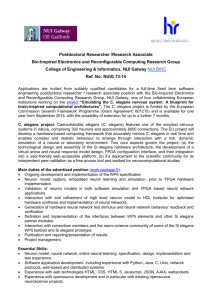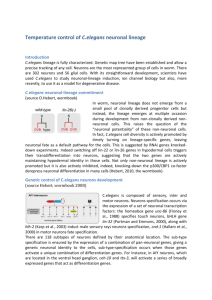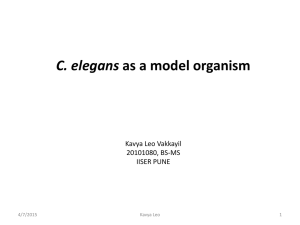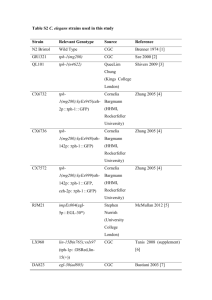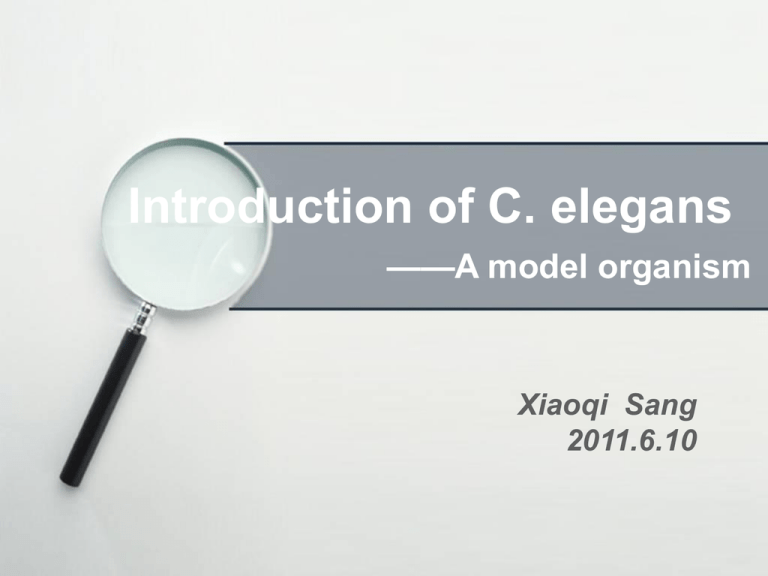
Introduction of C. elegans
——A model organism
Xiaoqi Sang
2011.6.10
Contents
A Short History
Characters of C.elegans
Applications of C. elegans
Nobel Prizes for C. elegans
C. elegans and Apoptosis
Page
2
Brief Introduction
whole name:Caenorhabditis elegans
Free-living, non-parasitic, transparent,
about 1 mm in length,lives in
temperate soil environments
Research into the molecular begun in
1974
Extensively used as a model organism
Page
3
A Short History
In 1963, Sydney Brenner
introduced C. elegans as a
model organism for pursuing
research in developmental
biology and neurology
In 1974, Brenner founded
that EMS can induction
specificity gene mutation of
C. elegans
Now is widely used in
laboratory research
Page
4
Characters of C. elegans
small (about 1 mm in length)
Feeds on bacteria
Easily to housed and cultivated in large numbers
Transparent
Easily to manipulation and observation
Life cycle is short
Have 1090 somatic cells at most
Easily to mutagism
Can be long-term storage
Genome is completely sequenced
Page
5
C. elegans
Page
6
C. elegans
Page
7
Life Cycle
From egg to egg
takes about 3 days
Life span is
around 2 to 3 weeks
under suitable
living condition
Once lay
approximately 3001000 eggs
Page
8
Life Cycle
Page
9
Genome
The genome was completely sequenced in 1998, It is
the first multicellular-organism (animal) that has a
completely sequenced genome
The genome size of C. elegans is about a hundred
million base pairs
Five pairs of autosomes and one pair of sex
chromosome
Contains approximately 20,100 protein-coding genes
Contain more than 16,000 RNA genes
Page
10
Sexual determination
C. elegans has two sexes: hermaphrodites and
males
In nature, hermaphrodites are the most common sex,
just 0.05% is males
Hermaphrodites can self-fertilize or mate with males
but cannot fertilize each other
sex determined by the ratio of sex chromosome
Page
11
XX
hermaphrodite
XO
male
Applications of C. elegans
Cellular differentiation
Nervous system
Embryo development
Cell cycle
Meiosis
Fertilization
Cleavage
Fat metabolize
RNA Interference (RNAi)
Study and memory
Aging
Apoptosis
Page
12
Nobel Prizes for C. elegans!
The first C. elegans Nobel Prize——The Nobel Prize in
Physiology or Medicine 2002
For the dicovery of Apoptosis
To Sydney Brenner, H. Robert Horvitz and John E. Sulston
A second C. elegans Nobel Prize——The Nobel Prize in
Physiology or Medicine 2006
For the discovery of RNA interference - gene silencing by
double-stranded RNA
To Andrew Z. Fire and Craig C. Mello
A third C. elegans Nobel Prize——The Nobel Prize in Chemistry
2008
For the discovery and development of the green fluorescent
protein
To Osamu Shimomura, Martin Chalfie and Roger Y. Tsien
Page
13
C. elegans and Apoptosis
C. elegans hermaphrodites have 1090
somatic cells
Mature C. elegans remains 959 cells
131 cells commit suicide by apoptosis
116 of the 131 dying cells are cells of the
nervous system and other ectoderm
Page
14
To be continue
15




